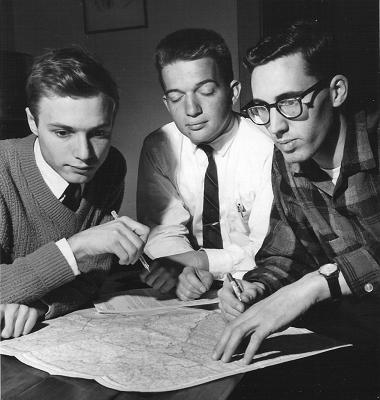Nonviolent Common Defense: The Biography of an Idea
by Gene Keyes

Gene Keyes, Dennis Weeks, and Joe Tuchinsky planning 1964 civil rights march route to Albany, Georgia
Editor’s Preface: The topic of nonviolent civilian defense was high on the agenda of the peace and nonviolence movements in the 1970s and 1980s. This essay is representative of that discussion, and is another in our series of discoveries from the War Resisters’ International archive. The article appears to be Chapter Two of the author’s “unpublished” PhD thesis for Toronto University; a pdf scan of the original is attached. Please also consult the notes at the end for archival reference, acknowledgment, biographical information about the author, and a link to his site. JG
The idea we are considering has had numerous names since the 1850s, and especially since the 1950s: passive resistance; nonresistance; nonviolent resistance; civil resistance; unarmed defense; nonviolent defense; nonmilitary defense; civilian defense; civilian resistance; nonviolent civilian defense; social defense; civilian-based defense; societal defense; post-military defense; etc..
An expression I would like to try out is “common defense,” but reinvigorated to mean an effort mounted by an entire polity using the nonviolent means at hand; with defiance and organization; with strategy, principle, and tenacity: common defense of everyone, by everyone, for everyone; common defense without nuclear weapons, firepower, or any other killing and violence; common defense as workaday resistance by an unconquerable free people.
The nineteenth century social activist Elihu Burritt wrote what may have been the earliest advocacy of nonviolent defense as early as July 1852. It was a series of short related essays on “passive resistance”. Like Leonardo’s helicopter, Burritt’s concept was ahead of its time, but it perfectly foreshadowed Gandhi’s satyagraha. The next earliest case for common defense seems to have been made by Bertrand Russell in an August 1915 article, “War and Non-resistance”. It was a proposal for concerted nonviolent resistance to the possibility of an invasion of England by Germany. Despite his prescience, Russell had unwisely used the obsolete, self-contradictory term “non-resistance”. Like Burritt, he never developed the idea further, despite his pacifist anti-war activism.
As for Mohandas K. Gandhi, this essay cannot do justice to his importance as the pioneer of strategic nonviolence. But it was not until 1931 that he began to notice the national defense implications of nonviolent resistance. For example, he earnestly recommend a nonviolent defense policy for Switzerland in 1931, Abyssinia in 1935, Czechoslovakia in 1938, and Britain in 1940, as well as for his own Congress Party, which rejected it in 1939, and again in 1940. Yet nonviolent defense was only one of many topics, from cows to celibacy, competing for Gandhi’s attention, and by no means his highest priority.
Read the pdf of the complete article here: Nonviolent Common Defense
Reference: IISG/WRI Archive Box 742: Folder 1. We are grateful to WRI/London and their director Christine Schweitzer for their cooperation in our WRI project.
EDITOR’S NOTE: Gene Keyes is a peace activist, emeritus professor of world politics, and an inveterate mapmaker. His website, at this link, has links to his writings, maps, and much else.




